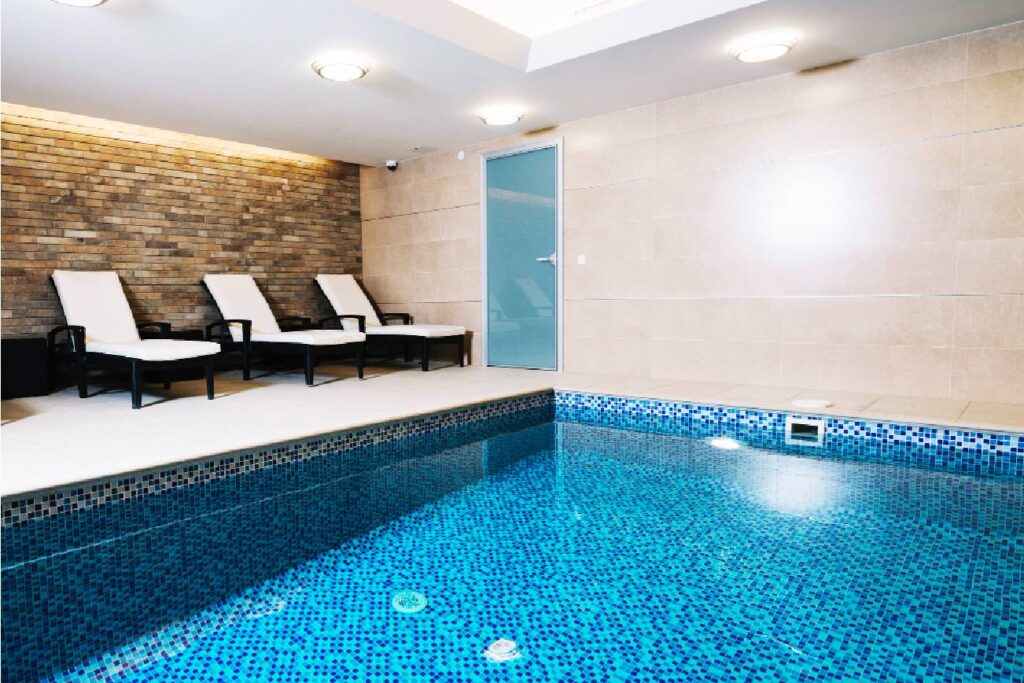Dehumidification air handling units in residences and villas with indoor pools are critically important to prevent mold, unpleasant odors, and structural damage caused by high humidity. These systems provide:
- Humidity Control: Absorb moisture evaporated from the pool water and maintain an ideal relative humidity level (50-60%).
- Energy Efficiency: Heat recovery models reduce heating costs.
- Air Quality: Fresh air supply prevents CO₂ and chloramine buildup.
- Corrosion Prevention: Minimize humidity-related metal and structural damage.
Preferred Systems:
- 100% Fresh Air Units: Ensure a hygienic environment.
- Heat Pump Dehumidifiers: Offer low operating costs.
- Smart Control Systems: Automatically adjust humidity and temperature.
When planning a project, consider air flow rate, heating capacity, and service life. Professional engineering support is recommended for optimal solutions.
Recommended Air Duct Materials
Due to high humidity and corrosion risks in indoor pool dehumidification systems, ducts made from special materials should be preferred:
- Stainless Steel (AISI 316) Ducts:
- High resistance to chlorine and moisture.
- Long-lasting; preferred in premium villas and residences.
- PVC-Coated Galvanized Steel Ducts:
- Durable in humid environments and cost-effective.
- Smooth inner surfaces reduce air resistance.
- FRP (Fiberglass Reinforced Plastic) Ducts:
- Fully resistant to corrosion.
- Lightweight and easy to install.
- Aluminum Ducts (With Special Coating):
- Lightweight and corrosion-resistant options should be selected.
Critical Factors in Duct Selection:
✔ Resistance to moisture and chemicals (chlorine and salty water vapor)
✔ Thermal insulation (to prevent condensation)
✔ Airtight sealing to prevent air leaks
Important Application Considerations
a) Design Phase
- Air Velocity: Should not exceed 2-3 m/s in ducts to avoid noise and energy loss.
- Airflow Calculations: Must be based on pool surface area, water temperature, and environmental conditions (typically 6-10 air changes per hour).
- Exhaust and Fresh Air Balance: Negative pressure in the pool area must be avoided to prevent odor and moisture spreading to other areas.
b) Installation and Insulation
- Condensation Prevention: Ducts should be covered with moisture-proof insulation such as closed-cell elastomeric foam or PVC-coated glass wool.
- Slope and Drainage: Proper slope and drainage points should be provided for condensate removal.
- Sound Insulation: Use high-quality vibration-absorbing connectors.
c) System Control and Maintenance
- Humidity Sensors: Maintain relative humidity at 50-60% with automatic control systems.
- Filter Maintenance: Filters must be cleaned or replaced frequently due to pool chemicals.
- Corrosion Monitoring: Regular inspection of ducts and connections is necessary.
Summary: Top 5 Critical Application Rules
- Choose corrosion-resistant duct materials (stainless steel or PVC-coated galvanized steel).
- Keep air velocity low to ensure energy efficiency and quiet operation.
- Insulate all ducts against condensation.
- Maintain proper exhaust-fresh air balance (slightly positive pressure in the space).
- Continuously monitor humidity with an automation system.
By following these rules, long-lasting, efficient, and trouble-free HVAC systems for indoor pools in residences and villas can be achieved.
Keywords
indoor pool dehumidification, villa HVAC units, residential ventilation systems, humidity control, pool dehumidification equipment, energy-efficient HVAC, comfortable ventilation, healthy indoor climate, HVAC solutions, indoor pool climate control
